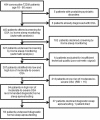The Clinical Impact of Systematic Screening for Obstructive Sleep Apnea in a Type 2 Diabetes Population-Adherence to the Screening-Diagnostic Process and the Acceptance and Adherence to the CPAP Therapy Compared to Regular Sleep Clinic Patients
- PMID: 30555416
- PMCID: PMC6282364
- DOI: 10.3389/fendo.2018.00714
The Clinical Impact of Systematic Screening for Obstructive Sleep Apnea in a Type 2 Diabetes Population-Adherence to the Screening-Diagnostic Process and the Acceptance and Adherence to the CPAP Therapy Compared to Regular Sleep Clinic Patients
Abstract
Obstructive sleep apnea (OSA) is a common disorder in Type 2 diabetes (T2D) patients further increasing their already high cardiovascular risk. As T2D patients typically not report OSA symptoms, systematic screening for OSA in this population is warranted. We aimed to determine the readiness of T2D patients to undergo screening and to compare their adherence to continuous positive airway pressure (CPAP) therapy with "regular" sleep clinic patients who typically seek medical advice on their own initiative. We therefore recruited 494 consecutive T2D patients and offered them OSA screening using home sleep monitoring (type IV device). All participants in high risk of moderate-to-severe OSA were recommended home sleep apnea testing (HSAT) followed by CPAP therapy. Patients were followed-up for 12 months and outcomes compared to 228 consecutive sleep clinic patients undergoing HSAT. Among 307 screened T2D patients, 94 (31%) were identified at high risk of moderate-to-severe OSA. Subsequently, 54 patients underwent HSAT, 51 were recommended, and 38 patients initiated CPAP (acceptance 75%). Among 228 sleep clinic patients, 92 (40%) were recommended and 74 patients initiated CPAP (acceptance 80%). After 1 year, 15 (39%) T2D and 29 (39%) sleep clinic patients showed good CPAP adherence (use ≥ 4 h/night ≥ 70% nights). In conclusion, 20 T2D patients needed to be screened in order to obtain one successfully treated patient. OSA screening in T2D patients identified 31% with moderate-to-severe OSA. Once diagnosed, their CPAP acceptance and adherence did not differ from sleep clinic patients. However, the reasons for the high dropout during the screening-diagnostic process impacting the overall success of the screening program need to be identified and addressed.
Keywords: CPAP acceptance; CPAP adherence; diabetes; screening; sleep apnea.
Figures
Similar articles
-
Long-term adherence to nasal continuous positive airway pressure therapy by hypertensive patients with preexisting sleep apnea.J Cardiol. 2014 Apr;63(4):281-5. doi: 10.1016/j.jjcc.2013.08.013. Epub 2013 Oct 20. J Cardiol. 2014. PMID: 24148860
-
Beneficial Effects of Long-Term CPAP Treatment on Sleep Quality and Blood Pressure in Adherent Subjects With Obstructive Sleep Apnea.Respir Care. 2015 Dec;60(12):1810-8. doi: 10.4187/respcare.04199. Epub 2015 Sep 22. Respir Care. 2015. PMID: 26396261
-
Acceptance and Adherence to Continuous Positive Airway Pressure Therapy in patients with Obstructive Sleep Apnea (OSA) in a Southeast Asian privately funded healthcare system.Sleep Sci. 2017 Apr-Jun;10(2):57-63. doi: 10.5935/1984-0063.20170010. Sleep Sci. 2017. PMID: 28966740 Free PMC article.
-
Optimal treatment of obstructive sleep apnea and excessive sleepiness.Adv Ther. 2009 Mar;26(3):295-312. doi: 10.1007/s12325-009-0016-7. Epub 2009 Apr 3. Adv Ther. 2009. PMID: 19337706 Review.
-
The use of auto-titrating continuous positive airway pressure for treatment of adult obstructive sleep apnea. An American Academy of Sleep Medicine review.Sleep. 2002 Mar 15;25(2):148-73. Sleep. 2002. PMID: 11902425 Review.
Cited by
-
Clinically available predictors of obstructive sleep apnoea requiring treatment in type 2 diabetes patients in primary care.Sci Rep. 2025 Mar 13;15(1):8710. doi: 10.1038/s41598-025-93362-1. Sci Rep. 2025. PMID: 40082634 Free PMC article.
-
The association of age with continuous positive airway pressure ventilation acceptance in an outpatient cohort of patients with obstructive sleep apnea.J Clin Sleep Med. 2022 Jan 1;18(1):217-224. doi: 10.5664/jcsm.9544. J Clin Sleep Med. 2022. PMID: 34279215 Free PMC article.
-
Hypoxia-Induced Sarcoplasmic Reticulum Ca2+ Leak Is Reversed by Ryanodine Receptor Stabilizer JTV-519 in HL-1 Cardiomyocytes.Anatol J Cardiol. 2022 Jun;26(6):476-484. doi: 10.5152/AnatolJCardiol.2022.1223. Anatol J Cardiol. 2022. PMID: 35703484 Free PMC article.
-
American Association of Clinical Endocrinology Clinical Practice Guideline: Developing a Diabetes Mellitus Comprehensive Care Plan-2022 Update.Endocr Pract. 2022 Oct;28(10):923-1049. doi: 10.1016/j.eprac.2022.08.002. Epub 2022 Aug 11. Endocr Pract. 2022. PMID: 35963508 Free PMC article.
-
Muscle Lipid Oxidation Is Not Affected by Obstructive Sleep Apnea in Diabetes and Healthy Subjects.Int J Mol Sci. 2023 Mar 10;24(6):5308. doi: 10.3390/ijms24065308. Int J Mol Sci. 2023. PMID: 36982383 Free PMC article.
References
-
- Young T, Evans L, Finn L, Palta M. Estimation of the clinically diagnosed proportion of sleep apnea syndrome in middle-aged men and women. Sleep (1997) 20:705–6. - PubMed
LinkOut - more resources
Full Text Sources
Research Materials



